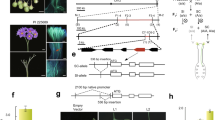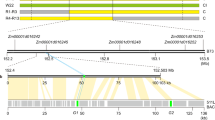Abstract
THE anthocyanins of diploid cultivated potatoes (2n = 24) are controlled by at least two independent loci of which one, P, is epistatic to the other R1. Three closely linked loci, B, I and F, on another chromosome, are concerned with the distribution of pigment on the body of the plant. Locus I in its homozygous recessive phase ii is epistatic to the two colour loci and leads to the absence of pigment in the tuber, to which organ its main action is localized. Locus F governs the contrast between flecked and self-coloured flowers. The former are homozygous recessives, ff; they are mainly white, but show dashes of colour on and around the vascular ‘star’ which is characteristic of the corolla. Loci I and F have shown a recombination value of 1.98 ± 0.62 per cent.
This is a preview of subscription content, access via your institution
Access options
Subscribe to this journal
Receive 51 print issues and online access
$199.00 per year
only $3.90 per issue
Buy this article
- Purchase on Springer Link
- Instant access to full article PDF
Prices may be subject to local taxes which are calculated during checkout
Similar content being viewed by others
References
Dodds, K. S., and Long, D. H., J. Genet, (in the press).
Hawkes, J. G., I.A.B. Bull., pp. 142 (1944).
Lewis, E. B., Genetics, 33, 113 (1948). Green, M. M., and Green, K. C., Proc. U.S. Nat. Acad. Sci., 35, 586 (1949).
Laughnan, J. R., Proc. U.S. Nat. Acad. Sci., 35, 167 (1949).
Author information
Authors and Affiliations
Rights and permissions
About this article
Cite this article
DODDS, K. Positional Pseudo-Alleles in Diploid Potatoes. Nature 175, 394–395 (1955). https://doi.org/10.1038/175394a0
Issue Date:
DOI: https://doi.org/10.1038/175394a0
This article is cited by
-
Production of haploids of potato (Solanum tuberosum subsp. tuberosum) and their identification with electrophoretic analysis
Euphytica (1993)
-
Inheritance of two qualitative traits and a proposed genetic map for their linkage group in diploid potatoes
Potato Research (1974)
-
Selection from Solanum tuberosum group phureja of genotypes combining high-frequency haploid induction with homozygosity for embryo-spot
Euphytica (1973)
-
Genetics of spectacle in diploid potatoes
Heredity (1969)
-
The inheritance oe colour in diploid potatoes II. A three-factor linkage group
Journal of Genetics (1956)
Comments
By submitting a comment you agree to abide by our Terms and Community Guidelines. If you find something abusive or that does not comply with our terms or guidelines please flag it as inappropriate.



